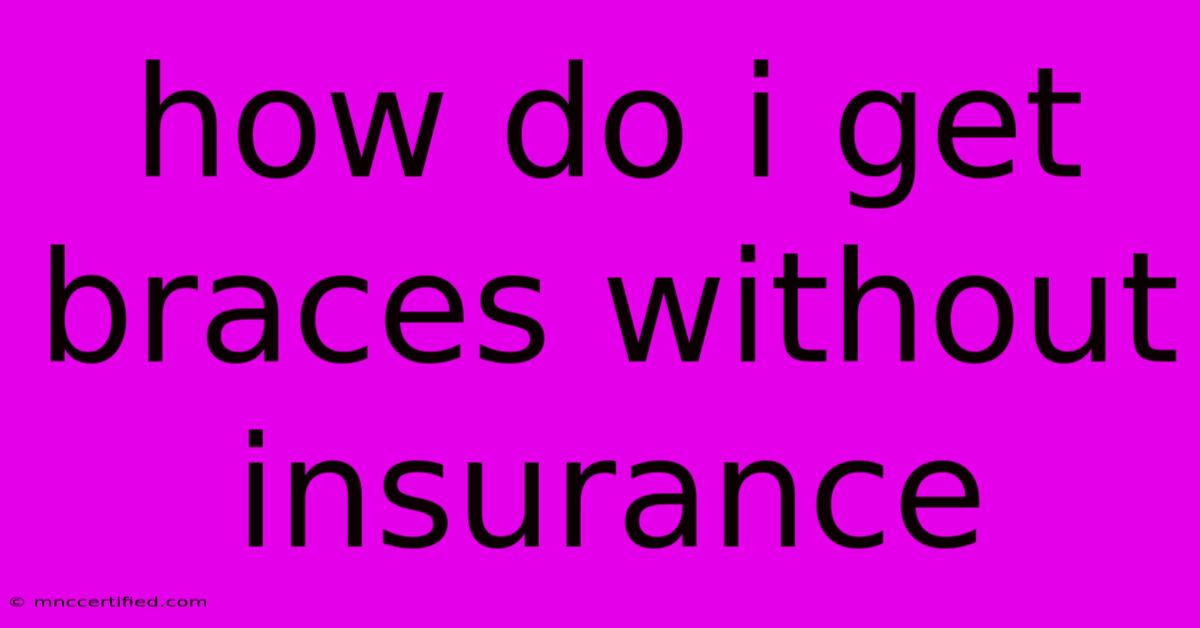How Do I Get Braces Without Insurance

Table of Contents
How to Get Braces Without Insurance: A Guide to Affordable Orthodontic Care
A straight, healthy smile is something many people desire. However, the cost of braces can be a significant barrier, especially without dental insurance. Don't despair! There are several ways to access orthodontic treatment even without insurance coverage.
This guide provides a comprehensive overview of options to help you achieve your dream smile without breaking the bank.
1. Payment Plans and Financing Options
Many orthodontists offer flexible payment plans to make treatment more manageable. These plans allow you to pay for braces in monthly installments, often interest-free.
Financing options are also readily available. Some common lenders include:
- CareCredit: This popular healthcare financing option allows you to pay for braces over time with monthly payments.
- Alphaeon Credit: A dedicated medical credit card that provides financing for orthodontic treatment.
- Your orthodontist's own financing program: Some orthodontists offer their own in-house financing options with varying terms and conditions.
2. Explore Local Resources and Programs
Community Health Centers: Look into your local community health centers. They often offer sliding-scale fees based on your income, potentially making braces more affordable.
State and Local Programs: Research state and local programs for financial assistance with dental care. Some areas may have programs specifically geared towards low-income individuals or families seeking orthodontic treatment.
Dental Schools: Dental schools frequently offer discounted services, including braces, to patients seeking treatment. These services are often provided by students under the supervision of licensed dentists, ensuring high-quality care.
3. Consider Alternative Orthodontic Treatments
Clear Aligners: While traditional braces are still the gold standard, clear aligners like Invisalign offer a discreet and convenient alternative. The cost of clear aligners may be more manageable, and some providers offer financing options.
Removable Appliances: In some cases, removable appliances like retainers or palatal expanders can address specific orthodontic issues at a lower cost compared to full braces.
Consult with Your Orthodontist: Always consult with a qualified orthodontist to determine the most appropriate treatment for your needs and budget. They can discuss different treatment options, explain costs, and explore potential financial assistance options.
4. Negotiation and Budgeting
Negotiate Payment Terms: Don't hesitate to negotiate payment terms with your orthodontist. Ask about discounts for upfront payments or explore options for spreading payments over a longer period.
Budget Carefully: Braces are an investment in your health and well-being. Create a detailed budget, factoring in the cost of braces, potential monthly payments, and any associated expenses like retainer costs.
Prioritize Savings: Set aside a portion of your income each month to save for braces. Consider opening a separate savings account specifically for this purpose.
5. Explore Second Opinions
Seeking Multiple Quotes: Don't settle for the first quote you receive. Contact several orthodontists in your area to obtain multiple quotes and compare treatment options.
Comparison of Payment Plans: Carefully review the payment plans offered by different orthodontists to ensure you find the most favorable terms.
Conclusion
Getting braces without insurance doesn't have to be a financial burden. By exploring these options and taking proactive steps, you can access affordable orthodontic treatment and achieve the confident smile you deserve. Remember, prioritizing your oral health is an investment in your overall well-being!

Thank you for visiting our website wich cover about How Do I Get Braces Without Insurance. We hope the information provided has been useful to you. Feel free to contact us if you have any questions or need further assistance. See you next time and dont miss to bookmark.
Featured Posts
-
Pete Wicks Tears Up On Strictly Come Dancing
Nov 10, 2024
-
Kw Specialty Insurance Company Rating
Nov 10, 2024
-
Public And Products Liability Insurance
Nov 10, 2024
-
Prithvi Shaws Birthday Dance Goes Viral
Nov 10, 2024
-
Indiana Hoosiers Vs Michigan Football Streaming
Nov 10, 2024